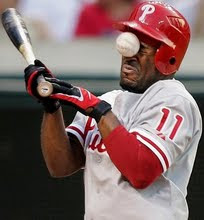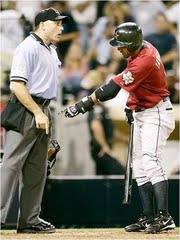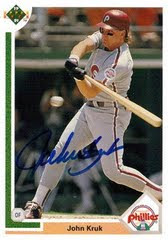The following is my latest article for The Hardball Times.
Today, the Cubs signed David DeJesus to a two-year, $8.5 million deal with a third-year option worth $6.5 million with a $1.5 million buyout. In other words, the Cubs signed a defensively adept outfielder/health risk with an average/slightly above average bat to a two-year, $10 million deal with a third-year marginal option cost of $5 million.
Using last year's market win value, they are essentially paying for a +1.0 WAR player each of the next two years (three, if they exercise his option). As identified in our 2012 Cubs offseason article, this is an excellent buy-low move.
Given DeJesus' age and health risks (he is 32 and only played a combined 222 games between 2010 and 2011, only once playing 150 games in a single season and only twice playing 140 over his eight-year major league career), $5 million a year might seem like merely fair compensation, while a two-year deal with a mandatory buyout might seem slightly generous.
However, contrary to that gut reaction, it is an extremely team-friendly deal in more ways than one. It not only is an expected surplus-value-providing contract, but, as will be explained below, it is also one that empowers the Cubs with extra payroll/positional flexibility to move Alfonso Soriano.
Let's begin by looking at DeJesus and his contract. First off, he is coming off his second-worst year in the majors since his rookie season. He only batted .240/.323/.376 (.309 wOBA), which is what enabled the Cubs to sign him so cheap in the first place.
However, even with such a poor batting line, DeJesus was still worth +2.2 WAR last season. Thanks to strong outfield defense (career +6 UZR/150 defender in the corners) and above-average base running (as measured by UBR) abilities (this despite being a career 51-for-97 base stealer), DeJesus is still an above-average major league player when his bat disappoints and he only plays 130 of his team's 162 games.
Accord to the world according to xBABIP, DeJesus was pretty unlucky with his balls in play in 2011. His .274 BABIP last year was a career low (by .015 points), and despite an uptick in strikeouts (17.0 percent compared to a career rate of 13.4 percent), DeJesus continued to drive the ball with authority (20.2 percent line drive rate). The result was an expected BABIP of .309, which was a full .035 points ahead of his actual results.
If we adjust DeJesus' batting line to reflect his xBABIP-based "true talent" line, then we should have expected him to hit .268/.347/.388 (.735 OPS) last season. Using his career BABIP rate (.316) in lieu of xBABIP, we could have expected a marginally better batting line of .273/.352/.393 (.745 OPS).
Oliver projects DeJesus for a .326 wOBA in Oakland for 2012 (.741 OPS). Such an improvement would mean the addition of 7-8 batting runs to DeJesus' 2011 batting value, bringing his expected 2011 WAR production to right about +3.0. And that's before you consider the move from spacious Oakland to Wrigley.
Those numbers might be off his career batting line of .284/.356/.421 (.776 OPS), but when you consider that the Oakland Colluseim played as a far worse hitters park than Kaufman Stadium last year, as it has for the past few seasons, especially for left handed batters—Kansas City has a slightly inflating wOBA index of 103 for lefties, while Oakland has a deflating index of 95—then the numbers really are not that far apart. And remember that offense around the league as a whole was down last year relative to the past few years.
So let's say DeJesus' talent line is not far off his career rate, maybe slightly below it. What can we expect from Wrigley's effects on DeJesus? For starters, it should help boost his very average power. Wrigley Field has a 120 index for left-handed home run power. That means DeJesus should be capable of 15 or more dingers if he can play 150 games (a big if, of course).
Wrigley also means that DeJesus should see a jump in his overall wOBA production. The Friendly Confines is one of the more notorious hitters parks in the National League, and as hinted above, the park tends to help left-handed hitters more than right-handed hitters.
Given that DeJesus was worth +2.2 WAR in only 131 games last season in one of baseball's most offense-zapping parks, I full expect him to be worth at least +3.0 WAR at Wrigley next season—keeping all else constant—with +4.0 WAR upside if he can stay healthy. At the very least, he should be able to turn in a pair of +2.0-2.5 WAR seasons for the Cubs.
If we pessimistically assume the DeJesus will only be worth between +4.0 and +5.0 cumulative WAR over the next two years, that makes his contract worth between $10 and $15 million dollars in "surplus" value to the team. If he is capable of something more, say +7.0 WAR over the next two years, that surplus value conceivably jumps to $25 million.
Let's take the pessimistic median of these projected ranges, for simplicity's sake, and assume for a moment that DeJesus' contract is worth a surplus value of $16 million over the next two years. What does this mean for the Cubs?
It means they are able to move Soriano without being prematurely forced to lean on Brett Jackson, for two reasons. First, DeJesus can simply take over Soriano's spot in the lineup. DeJesus has mostly played right the past few seasons, but he is no stranger to left (let alone center) field.
More importantly, however, it allows the Cubs to "eat" more of Soriano's salary without any real effect on the team's relative payroll and production. For every surplus production dollar that DeJesus is worth to the team, that is one dollar that can give away, for nothing, without changing the pre-signing status quo.
Soriano's remaining contract is essentially a three-year, $54 million deal. That's an $18 million annual expenditure, or $4 million more per year than Adam Dunn is making. If the Cubs were willing to eat half of Soriano's salary ($27 million) to move him before the DeJesus signing, this deal could potentially mean the team could eat up to an additional $16 million without being in any worse of a financial situation in terms of dollars spent and expected wins.
In other words, they potentially could be offering teams a three-year, $11 million-dollar commitment to obtain Soriano. That's roughly the fair market value of a single season of a player like Carlos Pena, which would make Soriano incredible attractive to even small-market teams.
More likely, however, it means the Cubs can now eat half of Soriano's salary without handcuffing their productive future (they go from "eating" $26 million to effective "eating" $10 million). While the money will still be sunk into Soriano's contract regardless, the value gained from the DeJesus deal will recoup much of that sunk cost.
Of course this all assumes a relatively flat aging curve and no adverse changes in health, which are bold assumptions. Nonetheless, I think this will prove to be a fantastic deal for the Cubs and a great sign of the shrewd, positive things to come during the Epstein/Hoyer era.
Welcome to the north side, Mr. DeJesus (and goodbye Soriano?)
Posted by
David "MVP" Eckstein
on Wednesday, November 30, 2011
Labels:
baseball,
Chicago Cubs







0 comments:
Post a Comment